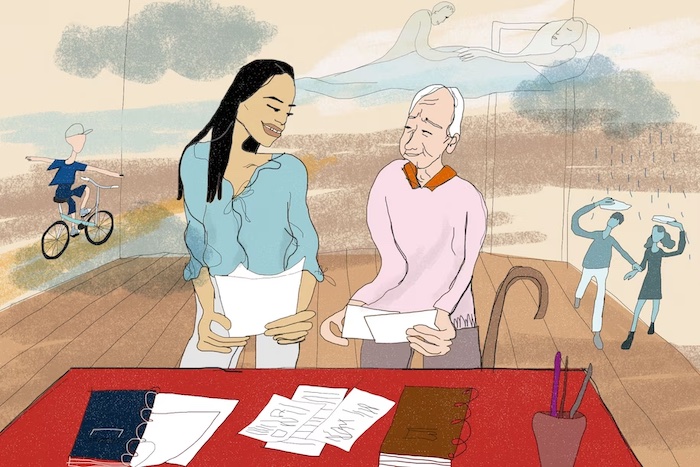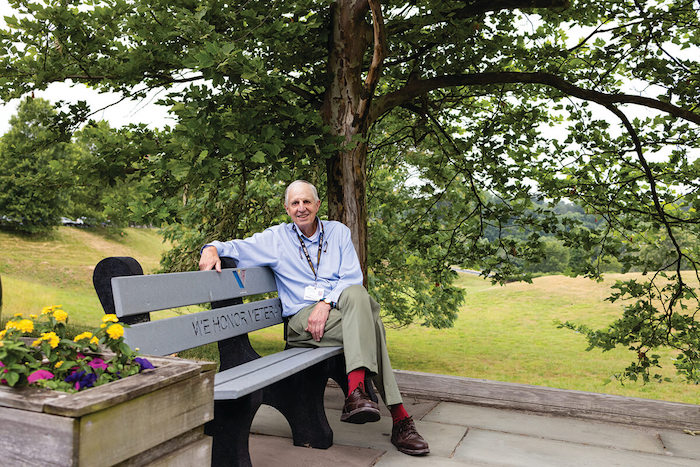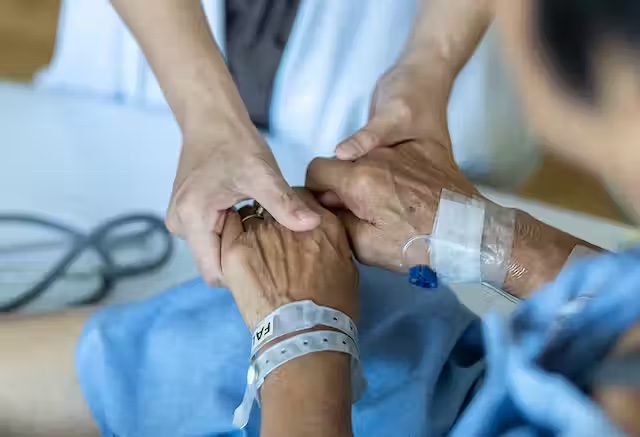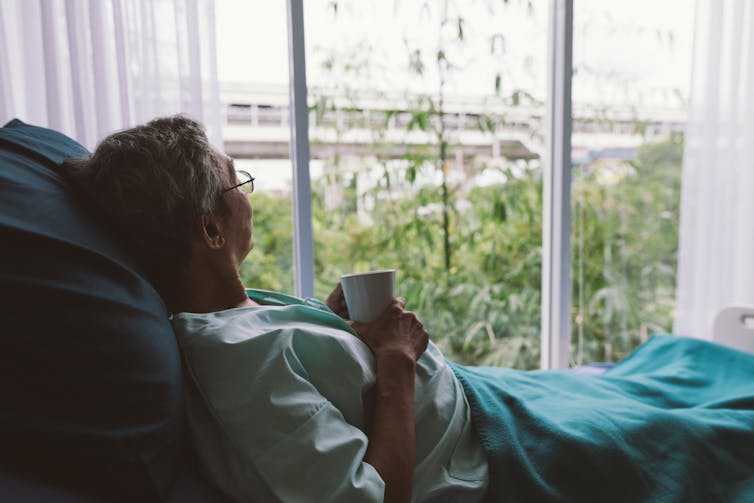— Here are 5 things to consider first.

Many of us say that if we have to die, we’d like to die comfortably in our home. Luckily, hospice—a Medicare-covered model of gentle, holistic end-of-life care—is ready to help with that goal.
Maybe.
by Laura Kelly
At age 78, my divorced father was diagnosed with Stage 4 colon cancer. He later admitted that he’d skipped getting any colonoscopies. He was a savvy healthcare researcher and, via drug trials, controlled the spread of his cancer for four long years. Then came the day his doctor said, “There are no more treatments left, Larry. Call your kids and sign up for hospice. Today.”
If you’re hazy about what hospice is, as my family was, check out Medicare’s hospice page that details the conditions that qualify you for hospice care and what costs Medicare will cover. You might also check out a 2023 New York Times article that sheds light on how hospice functions today. The industry has traveled far from its grassroots, volunteer origins of 40 years ago.
By the time I was flying from New York to Michigan to “help out,” my busy brother David had made the executive decision to move my father from his cluttered condo to David’s larger family home across town. My brother’s wife, 9-year-old daughter and three large dogs were no doubt a bit flummoxed when David deposited my hospice-unready father into the ground-floor master bedroom. But my father and everyone else were united in wanting the proverbial “good death” in the comfort of a home, even if it wasn’t his.
What happened during that home hospice experience surprised me. After it was over, I compared notes with friends. It seems that what my family went through might not be typical. Still, it could be a portent of what’s to come as the baby boomer bulge meets the realities of understaffed hospice care. Here are five takeaways if you’re ever considering home hospice for a loved one—or yourself.
1. Research hospice options before you need them
As my father and family found out, the very end is much too late to think about hospice—both for taking advantage of hospice’s full psychosocial benefits and for finding out what you’re getting into.
The hospice provider, which had been suggested to my father by his doctor’s office, turned out to be severely overstretched. We had only four short visits from a hospice nurse—a different person each time—during the 11 fraught days of my father’s end-of-life passage. It was also impossible to get the hospice doctor on the phone to answer our ongoing questions. Even so, we could never find the time to research and switch to another organization.
Since events can overtake you at the end of life, spend an hour today learning which hospice providers operate in your area. AARP keeps an excellent updated page with facts about hospice, including questions to ask when you interview organizations. Your future self will thank you.
2. Know what equipment and services to ask for
Beyond the electric hospital bed, rolling bedside table and plastic commode that the hospice group delivered, my brother’s home was not equipped for a dying person. Side note: At the intake meeting where we met with hospice nurse No. 1 and a social worker, we all agreed that the bed was much too short for my 6’4″ father. He requested a replacement, but one never arrived. We should have kept asking.
We quickly found ourselves making daily runs to a nearby Target for more towels, more large and small pillows for propping up, more pajamas, cooling patches, ice packs, a small table fan that my father could angle, sheets, blankets, sippy cups and dry-mouth swabs, plus an intercom because my father’s voice weakened too much to call for us in another room. My credit card got a workout.
3. Be prepared to hire help
As much as we tried to make my father comfortable, it seemed impossible. He was plagued by restlessness and couldn’t sleep or be convinced to stay in bed. Someone had to be near him around the clock to prevent a fall in his weakened state.
After six sleepless nights, we called the hospice phone line yet again with questions about the situation, and a nurse on the line finally filled us in on “terminal agitation,” a not-uncommon occurrence at end of life for cancer patients, even though no one in our family had heard of it. She told us that this kind of metabolic restlessness was worse than pain because it could not be soothed by painkillers. “Call us again if you need to,” she wrapped up.
By then, we realized that our home hospice team was mostly voices on the phone, not the on-site caretakers we’d expected. A concerned long-distance relative emailed me: “Get yourself some nighttime help so you can sleep.”
I had no idea how to find good health aides at short notice, but it turned out that “good” wasn’t the issue. We just needed someone to sit near my sleepless father, so we caretakers could get some rest. I also needed time to coordinate events outside of hospice, such as lining up a funeral home to call when my father died. In the end, I pretty much handed over my credit card to three different aide services to help us patch together 24/7 coverage until the end.
Will you need expensive additional aides for home hospice? Maybe, so be prepared by getting the names of aide services and interviewing them at the beginning of the hospice process, so they’re just a phone call away if needed.
4. Someone needs to be in charge
Continuity of care was a big problem for us and my father. There was a revolving stream of new hospice personnel and eight different aides, along with a churn of visits from nearby relatives and phone calls from folks farther afield. Meanwhile, every day brought changes and challenges as the end of life approached.
It took me far too long to realize that neither my father nor the home hospice team were running the show; I was. In unfortunate timing, during these hospice days, my brother had been pulled away to manage an ongoing crisis at his company. Still, every night, David remained on call to help me or an aide. He was the only one who could support my tall father as he restlessly moved from bed to nearby chair to commode.
Needless to say, my brother was exhausted. After another of these nights, I emailed my two sisters what came to be known as “the bossy note,” telling them exactly what was needed from them beyond the occasional visits bearing baked goods. It was all-hands-on-deck time.
I suggest that upon hospice enrollment or before, everyone should agree on a point person. This coordinator would have the overview of the home hospice situation, be given the latitude to set the ground rules and make decisions, and be allowed to delegate whatever to whomever, as needed.
5. Hospice at home may mean a nonprofessional will be in charge of medications
One of the hallmarks of hospice is the comfort care provided. On the first day, as I followed the intake hospice nurse on her way out the door with my list of anxious questions, she stopped me by handing over what she called a “comfort box.”
I pried open the white cardboard box and saw a confusing array of vials, syringes and suppositories. I thrust the box back toward her. “This is all for you to use, right?”
“No, they’re for you,” she said. “If your father needs them, you can call us. Put the box in the refrigerator where you can find it fast.” Then she left.
I immediately regretted that I didn’t ask her to go over each and every medication and how to use it, recording her explanation using my cellphone.
Later on, when I hired the aide services to help us through the final days and nights, I found out the aides weren’t allowed by their companies to prepare the needed antianxiety and sedative medications, and they could only give them to the patient when directed by someone in charge, meaning me. If I wasn’t awake to direct them, my father wouldn’t get his comfort meds.
As my shaking hands prepared morphine syringes and crushed Ativan pills in the middle of the night, I thought, “I would never expect or want someone like me to do this for me.”
My advice: When you’re doing those early interviews with prospective home hospice providers, ask who will actually dispense the medications. Maybe you’ll find out the home hospice nurses will be there to do it. But in our case, they weren’t.
My father died on Oct. 25, 2015, after his 11 days of home hospice care.
Was it the good death my dad had hoped for? I’ve never shared this with my siblings, but I don’t entirely think it was. My father had always prided himself on being the problem solver, not the problem maker. While we tried to hide our distress, he couldn’t help but notice how unprepared his kids were to supervise this 24/7 medical undertaking.
One late night, as I lay awake on the king bed beside my restless father in his little hospital bed, he told me he was sorry about “all the trouble I’m causing,” as he put it.
“I didn’t imagine it would go like this,” he said quietly. “No help. No sleep. Not knowing what’s coming next. Thank you for everything you’re doing.”
I reached over and touched his hand. “Dad, I am so grateful to be here helping you through this after all you’ve done for us. Please don’t apologize. You’re no trouble at all.”
Later, I heard friends’ stories of their supported and peaceful experiences in dedicated hospice facilities. There, they could quietly share smiles and good memories, listen to music, even be served meals. A facility can perhaps more easily arrange quality-of-life options for the patient, such as expert bathing and therapeutic massages with oils. Most important, a facility would presumably be staffed with professionals who could administer the proper palliative medication. A place that’s designed and intended for end-of-life care clearly has some advantages.
If, however, you’re with the majority who would prefer using hospice in a familiar home setting, look into what’s entailed well ahead of time. Ensure that family or friends are willing and able to coordinate all the activities and decisions. Have a credit card ready for all the purchases and extra help you may need. And don’t make hopeful assumptions, as I did. Be proactive and ask the necessary questions, so you or your loved one gets the quality end-of-life care all of us deserve.
Complete Article ↪HERE↩!








